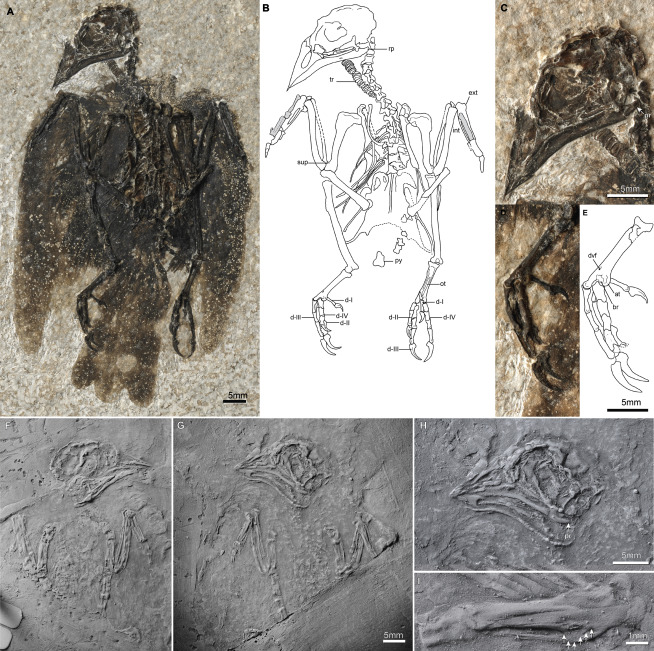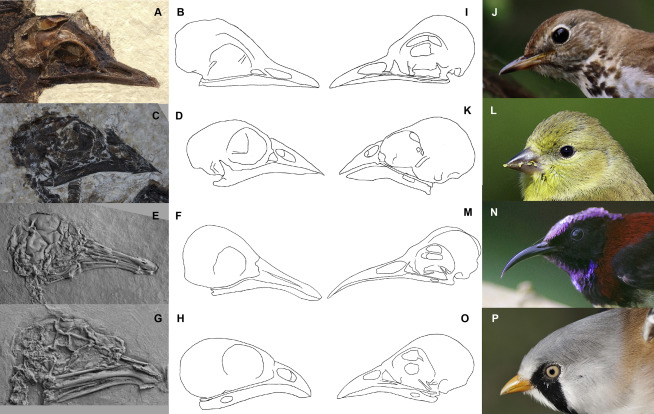@WFS,World Fossil Society,Riffin T Sajeev,Russel T Sajeev
A 52-million-year fossil of a “perching bird” has been found in Wyoming with its feathers still attached, a discovery that “no one’s ever seen before.”
Also known as passerines, the perching bird was discovered in Fossil Lake, WY. Passerines are well-known for eating seeds, as most modern-day birds do and account for approximately 65 percent of the 10,000 different species of birds alive today.

Figure 1Morphology of Eofringillirostrum
(A) Photograph and (B) line drawing of the holotype skeleton of Eofringillirostrum boudreauxi (FMNH PA 793) with enlargements showing details of the (C) skull and (D) foot, and (E) line drawing of foot. (F) Holotype slab (IRSNB Av 128a) and (G) counterslab (IRSNB Av 128b) of Eofringillirostrum parvulum with enlargements showing details of (H) skull and (I) carpometacarpus; for contrast enhancement, the specimen was coated with ammonium chloride. Abbreviations: at: accessory trochlea, br: base of the main body of fourth metatarsal trochlea (articular end broken off); d-I – d-IV: pedal digits I – IV, dvf: distal vascular foramen, ext: extensor process, int: intermetacarpal process, ot: ossified tendon, py: pygostyle, rp: retroarticular process, sup: dorsal supracondylar process, tr: tracheal rings. Arrows in (D) indicate borders of intermetacarpal process. Grey shaded regions in (B) indicate portions of the carpometacarpus that were displaced during splitting of the slab. See also Figure S2.
FIRST DINOSAUR FEATHER EVER DISCOVERED REVEALS MYSTERIOUS SECRETS
The study has been published in the scientific journal Current Biology.
Now known as Eofringillirostrum boudreauxi, the bird had a “finch-like beak,” similar to modern day finches and sparrows, which could give clues as to its diet.
![Figure 2Phylogenetic Relationships of Early Passerines Strict consensus of 394 most parsimonious trees (707 steps, RC = 0.174, RI = 0.626) based on analysis of 146 morphological characters enforcing the backbone constraint and divergence dates from [20]. Bootstrap support values are shown above the branches they pertain to, though note nodes that are constrained may receive artificially high support (e.g., Psittaciformes). Character list, scorings, and additional details of analyses are provided in the Supplemental Information and Figure S3.](http://www.worldfossilsociety.org/wp-content/uploads/2019/02/kangaro-ancient-2.jpg)
Figure 2Phylogenetic Relationships of Early Passerines
Strict consensus of 394 most parsimonious trees (707 steps, RC = 0.174, RI = 0.626) based on analysis of 146 morphological characters enforcing the backbone constraint and divergence dates from [20]. Bootstrap support values are shown above the branches they pertain to, though note nodes that are constrained may receive artificially high support (e.g., Psittaciformes). Character list, scorings, and additional details of analyses are provided in the Supplemental Information and Figure S3.
“The earliest birds probably ate insects and fish, some may have been eating small lizards,” Grande added. “Until this discovery, we did not know much about the ecology of early passerines. E. boudreauxi gives us an important look at this.”

Stem and Crown Passerines
(A–P) Images and comparative line drawings of the skull in (A–H) Eocene stem passerines and photographs of the head and line drawings of the skull in (I–P) crown passerines with a similar bill shape. Fossil taxa: (A and B) Morsoravis sp. (FMNH PA789), (C and D) Eofringillirostrum boudreauxi (FMNH PA 793), (E and F) Pumiliornis tessellatus (SMF-ME 11414a) and (G and H) Psittacopes lepidus (SMF-ME 1279). Extant taxa: (I and J) Catharus guttatus (Hermit Thrush, Turdidae), (K and L) Spinus tristis (American Goldfinch, Fringillidae), (M and N) Aethopyga saturata (Black-throated Sunbird, Nectariniidae) and (O and P) Panurus biarmicus (Bearded Reedling, Panuridae). Photo credits and sources for line drawings are provided in the Supplemental Information. Not to scale.
Fossil Lake has been home to several discoveries of past species, including birds, reptiles and early mammals, due in large part to what has been described as “perfect conditions.”
“We have spent so much time excavating this locality, that we have a record of even the very rare things,” Grande said.
TRIASSIC ‘LIZARD KING’ RULED ANTARCTICA BEFORE THE DINOSAUR
Fossil Lake provides a rare look into a world after the dinosaurs went extinct, but before mammals really started to take off and become the dominant form of life on Earth.
“I’ve been going to Fossil Lake every year for the last 35 years, and finding this bird is one of the reasons I keep going back. It’s so rich,” Grande added. “We keep finding things that no one’s ever seen before.”
Sources:Current Biology and Fox news
@WFS,World Fossil Society,Riffin T Sajeev,Russel T Sajeev



 February 11th, 2019
February 11th, 2019  Riffin
Riffin  Posted in
Posted in  Tags:
Tags: 